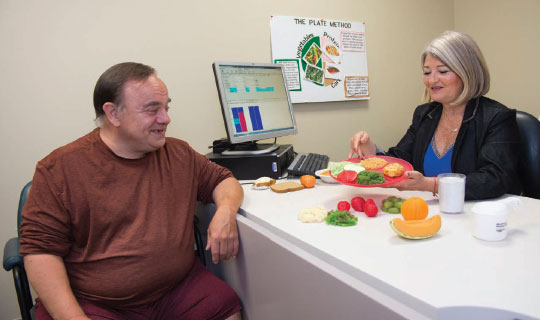“I feel much better, and my blood pressure has improved. I can’t thank Maria enough.”

Thanks to expert nutrition counseling, one patient dropped 60 pounds and improved his blood pressure.
At an appointment with his physician at Monmouth Medical Center (MMC) last April, Michael Dibiase of Long Branch discovered he had high blood pressure. “My doctor put me on a diet and sent me to a nutritionist to help me lose weight,” says Michael, who cares for his father, who has Parkinson’s disease, and weighed 268 pounds at the time. So Michael met with Maria Lodeiro-Skennion, RD, a nutritionist at MMC’s Center for Diabetes Education and Nutrition Services, which provides one-on-one nutrition counseling for obese adult and pediatric patients.
“Michael had a very positive attitude,” she recalls. “He said, ‘I need to be healthy for my father and myself.’”
A new way of eating
Initially, Michael saw Lodeiro-Skennion every other week. “She told me what to eat and what not to eat,” he recalls. Michael was in the habit of eating out a lot and enjoyed fried foods and large portions of pasta. He also didn’t exercise. Lodeiro- Skennion gave Michael grocery-shopping tips. She recommended that he read food labels and look for items with more fiber and less fat. For instance, she advised that he purchase lean meats, such as skinless chicken breast and low-fat turkey. She also encouraged him to shop for different types of vegetables and switch from soda to flavored sparkling water.
Lodeiro-Skennion also gave Michael healthy cooking tips. She recommends broiling or grilling foods instead of frying them and going light on salad dressing. “Michael used to use a lot of creamy, fatty salad dressings,” she says. “I told him, ‘You have to be able to taste the vegetables.’” Lodeiro-Skennion gave Michael a recipe for a salad dressing made with ginger root, garlic, cilantro and plain yogurt, and he loves it, she says. “Instead of chips, he eats vegetables now,” she says. “He dips carrots and celery in the dressing.”
For meals, Lodeiro-Skennion instructed Michael to fill half of his plate with vegetables or fruit; one-quarter with protein, such as lean meat or fish; and one-quarter with starches (bread, pasta, potatoes or corn). She also advised that he cut back on his pasta servings. Instead of filling a plate with it, he now eats half a plate of pasta and protein and fills the other half with vegetables. Lodeiro- Skennion also told Michael to avoid skipping meals, which he had done from time to time. “If you skip meals, you’ll be very hungry at your next meal and won’t be able to eat smaller portion sizes,” she explains.
Since Michael eats smaller amounts at meals, he has two healthy snacks in between. Lodeiro-Skennion recommended low-calorie but filling fare like vegetables with dip, fruit and nonfat yogurt. Occasionally, Michael treats himself to a chocolate chip granola bar. Michael writes down everything he eats and shares the information with Lodeiro-Skennion. “When I look at his food diary from five months ago, I can see how much his eating habits have improved,” she says.
Getting active
Exercise was also part of the plan. Lodeiro-Skennion advised that Michael walk three times a week for 30 minutes. Over time, she recommended gradually adding a day to the routine. Today, he walks daily for 45 minutes to an hour. Michael lost between five and eight pounds at every visit and now sees Lodeiro-Skennion once a month.
At press time, he had lost 60 pounds over the course of six months. “I feel much better, and my blood pressure has improved,” he says. “I can’t thank Maria enough.”
Recipe: Blue and green smoothie
Keeping diabetes at bay
Eating right can be a powerful way to avoid type 2 diabetes, which affects about 21 million adults in the U.S. One-third of the population has prediabetes, in which blood glucose levels are higher than normal, according to the Centers for Disease Control and Prevention. “About half of people with prediabetes can avoid the disease by making dietary changes,” says Kenneth M. Granet, MD, Chairman of the Department of Medicine at Monmouth Medical Center.
Dr. Granet recommends staying away from processed carbohydrates like pasta, white bread and cookies and switching to filling complex carbohydrates, such as brown rice, fruits and vegetables. Boost your intake of fiber-rich, whole-grain foods, such as oatmeal and brown rice. Avoid trans and saturated fats, which are often found in butter, and consume foods high in polyunsaturated fats, such as walnuts, sunflower seats, tofu and soybeans. Slash your sodium intake to less than 2,300 milligrams per day, and if you crave sweets, focus on natural sources, such as fresh fruit.
“Eating healthfully will not only improve your cardiac, kidney and vascular health, but it will also give you more energy,” says Dr. Granet.
The Center for Diabetes Education and Nutrition services help patients manage their diabetes and weight by providing education and support. For more information or to schedule an appointment, call: 732.923.5025.